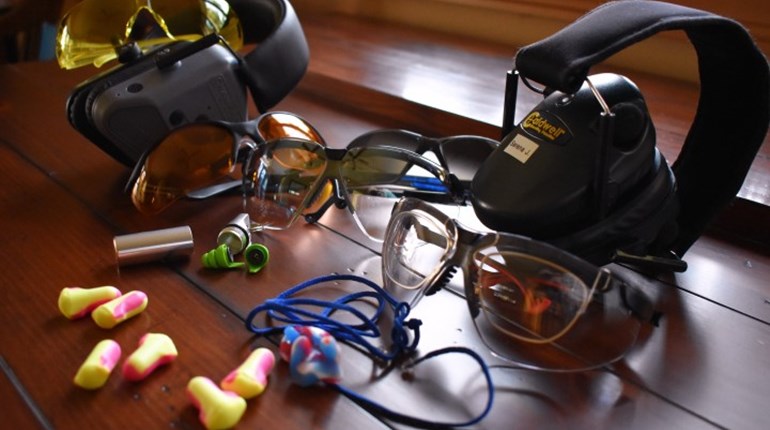
It’s clear that we’re seeing a lot of first-time gun owners right now for a variety of reasons. That’s fantastic - it is always a good thing when folks exercise their Second Amendment rights. We’re all hoping the new folks take a few classes and get quality training, and of course practice, practice practice. If you’re new to this whole shooting thing, though, you might not be aware of the gear you need to stay safe on the range. Here’s a rundown of the most critical pieces of protective equipment to bring when going shooting.
Eye protection
I think everyone understands the importance of protecting your eyes. It’s something we do when working with power tools, outdoor landscaping and many other endeavors - because bad things can happen in a fraction of a second and leave lasting, permanent damage. It should be abundantly clear why you should wear eye protection on the range - the potential for flying brass, burning powder and myriad other hazards is higher than normal.
Now, when it comes to eye protection, there’s a pretty big range in what you can get. Most home-improvement stores will have inexpensive plastic-frame lenses that will offer a fair amount of protection, all the way up through sophisticated, multi-lens offerings from known manufacturers like WileyX, Revision or ESS. Companies like Magpul and Leupold have recently gotten into the eyewear game, offering ANSI-rated eye protection that is as stylish as it is safe.
While any protection is better than nothing (those who wear corrective lenses might feel they don’t need additional protection, but conventional corrective eyewear is not always impact-resistant), look for glasses that wrap around slightly for the greatest level of protection.

Hearing protection
While it’s easy to see why you need to protect your eyes, hearing is more complicated. On an outdoor range, shooting handguns or .22 LR, it might be tempting to forgo the hearing protection - don’t. Hearing damage is cumulative and persistent; while you might not cause permanent damage on one trip, over time exposure to loud noises is going to take its toll. Even on trips where I’ve shot nothing but suppressed firearms I insist on hearing protection, simply because after a lifetime of shooting, riding motorcycles and operating power equipment I need to save every ounce of hearing I have left.
Again, like with eye protection you can spend a little or a lot; from cheap, bulk-pack foam plugs to Bluetooth-enabled in-the-ear units, you can spend pennies or hundreds. Often, a combination of devices works best: on an indoor range I find it advantageous to put in foam plugs, then ear muffs over them for the greatest level of protection. I recommend keeping an unopened package of foam plugs (or two!) in your range bag in case someone forgets their hearing protection.
Electronic hearing protection is an excellent choice for hearing instructions on the range, whether you’re teaching someone how to shoot, taking a class or just casually shooting with friends. Brands like Howard Leight, Caldwell, Peltor, Walkers and many others offer a range of ear protection with amplification that automatically cuts out during loud noises. In-the-ear options are more expensive, but offer less interference with eye wear or rifle stocks.
Simply, though, when it comes to hearing protection, use it. Use as much as you can. Even when you think you might not need it, you do.

Hats
Here’s something you might not think about as a piece of protective gear. If you’re shooting, well, pretty much any firearm that’s not a single-shot or revolver, flying brass can and does go everywhere. If the range has shooting bays, there are often partitions in close proximity to where the brass is ejecting from your firearm - one bounce and hot brass can be bouncing off your noggin (hence why we wear eyewear all the time…) It’s extremely unlikely you’ll suffer any significant damage from one piece of hot brass - but it can be distracting and potentially dangerous.
Appropriate Clothing
In this case, no tank tops, loose-fitting shirts or wide collars. Remember how I mentioned hot brass? It’s annoying when it bounces off your arm. It can be downright scary when a piece of hot brass goes down your shirt, especially if that brass winds up against your skin for more than a millisecond. Distractions on the range are bad. Pain is bad. There are horror stories (and videos to match) of shooters who, while enduring brass burns, inadvertently muzzle others on the range while trying to remove that brass. Wear the right clothing and it’s less likely to happen.
With that in mind, whenever possible wear long-sleeve shirts to maximize protection. As an added benefit, for the outdoor and/or backyard ranges, it offers protection against insects and irritating fauna as well. Use appropriate protective gear, pay attention to your surroundings and your new range outings will be enjoyable and safe.




































